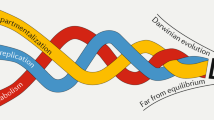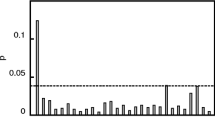Abstract
Self-replication, an important concept abstracted from reproduction, the key feature of life, remains vague in definition and lacking in clear interpretation in terms of its chemical mechanism. Mentioned frequently in discussions concerning the essence of life and its origin, the vague concept has caused a lot of uncertain statements, confusable references, and malposed debates, and has seriously held back efforts in this field. In this article, we try to improve the situation by a conceptual analysis in a more fundamental and clearer background. Self-replication in the substantial world could not mean anything but that “an entity favors the production of its own.” The major chemical mechanism for such favoring is catalysis, which can be classified into speed- and direction-favoring types (the template-directing function is actually a type of direction-favoring catalysis). Molecular self-replication could be based on autocatalysis or self-metabolism; the self-replication of a complex entity could be based on autocatalytic and/or self-metabolic sets, and should involve a mechanism of self-division. This conceptual clarification sheds light on the dim areas concerning the essence of life and its origin.

Similar content being viewed by others
References
Anet FA (2004) The place of metabolism in the origin of life. Curr Opin Chem Biol 8:654–659
Bachmann PA, Luisi PL, Lang J (1992) Autocatalytic self-replicating micelles as models for prebiotic structures. Nature 357:57–59
Bag BG, Von Kiedrowski G (1996) Templates, autocatalysis and molecular replication. Pure Appl Chem 68:2145–2152
Bartel DP (1999) Re-creating an RNA replicase. In: Gesteland RF, Cech TR, Atkins JF (eds) The RNA world. Cold Spring Harbor Laboratory Press, New York, pp 143–162
Blackmond DG (2004) Asymmetric autocatalysis and its implications for the origin of homochirality. Proc Natl Acad Sci USA 101:5732–5736
Bolm C, Gladysz JA (2003) Introduction: enantioselective catalysis. Chem Rev 103:2761–2762
Burmeister J (1998) Self-replication and autocatalysis. In: Brack A (ed) The molecular origins of life: assembling pieces of the puzzle. Cambridge University Press, Cambridge, pp 295–311
Cech TR (1989) RNA chemistry—ribozyme self-replication. Nature 339:507–508
Coontz R, Fahrenkamp-Uppenbrink J, Szuromi P (2003) Speeding chemistry along—introduction. Science 299:1683–1706
Cousins GRL, Poulsen SA, Sanders JKM (2000) Molecular evolution: dynamic combinatorial libraries, autocatalytic networks and the quest for molecular function. Curr Opin Chem Biol 4:270–279
Eigen M, Schuster P (1979) The hypercycle: a principle of natural self-organization. Springer, Berlin
Green R, Szostak JW (1992) Selection of a ribozyme that functions as a superior template in a self-copying reaction. Science 258:1910–1915
Hanczyc MM, Fujikawa SM, Szostak JW (2003) Experimental models of primitive cellular compartments: encapsulation, growth, and division. Science 302:618–622
Inoue T, Orgel LE (1983) A non-enzymatic RNA-polymerase model. Science 219:859–862
Jain SS, Anet FAL, Stahle CJ, Hud NV (2004) Enzymatic behavior by intercalating molecules in a template-directed ligation reaction. Angew Chem Int Ed 43:2004–2008
James KD, Ellington AD (1998) The endogenous synthesis of organic Compound. In: Brack A (ed) The molecular origins of life: assembling pieces of the puzzle. Cambridge University Press, Cambridge, pp 269–294
Joyce GF (1987) Non-enzymatic template-directed synthesis of informational macromolecules. Cold Spring Harbor Symp Quant Biol 52:41–51
Joyce GF (2002) The antiquity of RNA-based evolution. Nature 418:214–221
Joyce GF, Orgel LE (1999) Prospects for understanding the origin of the RNA World. In: Gesteland RF, Cech TR, Atkins JF (eds) The RNA world. Cold Spring Harbor Laboratory Press, New York, pp 49–77
Kauffman S (2000) Investigations. Oxford University Press, Oxford
Kozlov IA, Orgel LE (2000) Nonenzymatic template-directed synthesis of RNA from monomers. Mol Biol 34:781–789
Lee DH, Severin K, Ghadiri MR (1997) Autocatalytic networks: the transition from molecular self-replication to molecular ecosystems. Curr Opin Chem Biol 1:491–496
Luisi PL (1998) About various definitions of life. Orig Life Evol Biosph 28:613–622
Ma WT, Yu CW (2006) Intramolecular RNA replicase: possibly the first self-replicating molecule in the RNA world. Orig Life Evol Biosph 36:413–420
Mikami K, Yamanaka M (2003) Symmetry breaking in asymmetric catalysis: racemic catalysis to autocatalysis. Chem Rev 103:3369–3400
Noyori R (2002) Asymmetric catalysis: science and opportunities (Nobel lecture). Angew Chem Int Ed 41:2008–2022
Oberholzer T, Luisi PL (2002) The use of liposomes for constructing cell models. J Biol Phys 28:733–744
Orgel LE (1992) Molecular replication. Nature 358:203–209
Orgel LE (2000) Self-organizing biochemical cycles. Proc Natl Acad Sci USA 97:12503–12507
Orgel LE (2004) Prebiotic chemistry and the origin of the RNA World. Crit Rev Biochem Mol Biol 39:99–123
Paul N, Joyce GF (2003) Self-replication. Curr Biol 13:R46
Pross A (2004) Causation and the origin of Life. Metabolism or replication First? Orig Life Evol Biosph 34:307–321
Rasmussen S, Chen LH, Stadler BMR, Stadler PF (2004) Proto-organism kinetics: evolutionary dynamics of lipid aggregates with genes and metabolism. Orig Life Evol Biosph 34:171–180
Reggia JA, Lohn JD, Chou HH (1998) Self-replicating structures: evolution, emergence, and computation. Artif Life 4:283–302
Robertson A, Sinclair AJ, Philp D (2000) Minimal self-replicating systems. Chem Soc Rev 29:141–152
Ruiz-Mirazo K, Pereto J, Moreno A (2004) A universal definition of life: autonomy and open-ended evolution. Orig Life Evol Biosph 34:323–346
Segre D, Lancet D, Kedem O, Pilpel Y (1998) Graded autocatalysis replication domain (GARD): kinetic analysis of self-replication in mutually catalytic sets. Orig Life Evol Biosph 28:501–514
Shapiro R (2000) A replicator was not involved in the origin of life. IUBMB Life 49:173–176
Sipper M (1998) Fifty years of research on self-replication: an overview. Artif Life 4:237–257
Sipper M, Reggia JA, Emmite D (2001) Go forth and replicate. Sci Am 285:35–43
Strobel SA (2001) Biological catalysis—repopulating the RNA world. Nature 411:1003–1006
Szathmary E (2000) The evolution of replicators. Philos Trans R Soc B Biol Sci 355:1669–1676
Szathmary E (2006) The origin of replicators and reproducers. Philos Trans R Soc B Biol Sci 361:1761–1776
Szathmary E, Smith JM (1997) From replicators to reproducers: the first major transitions leading to life. J Theor Biol 187:555–571
Szostak JW, Bartel DP, Luisi PL (2001) Synthesizing life. Nature 409:387–390
Tjivikua T, Ballester P, Rebek J Jr (1990) A self-replicating system. J Am Chem Soc 112:1249–1250
Todd MH (2002) Asymmetric autocatalysis: product recruitment for the increase in the chiral environment (PRICE). Chem Soc Rev 31:211–222
Trost BM (2004) Asymmetric catalysis: an enabling science. Proc Natl Acad Sci USA 101:5348–5355
Versees W, Loverix S, Vandemeulebroucke A, Geerlings P, Steyaert J (2004) Leaving group activation by aromatic stacking: an alternative to general acid catalysis. J Mol Biol 338:1–6
Wintner EA, Rebek J (1996) Autocatalysis and the generation of self-replicating systems. Acta Chem Scand 50:469–485
Acknowledgments
Financial support from the National Natural Science Foundation of China (No. 30870660), the National 973 Fundamental Research Program (No. 2010CB530500, No. 2010CB530503), Hubei Natural Science Foundation of China (No. 2003S2113), and the State Key Laboratory of Software Engineering in Wuhan University (No. SKLSE01) is gratefully acknowledged.
Author information
Authors and Affiliations
Corresponding author
Rights and permissions
About this article
Cite this article
Ma, W., Yu, C., Zhang, W. et al. Self-replication: spelling it out in a chemical background. Theory Biosci. 130, 119–125 (2011). https://doi.org/10.1007/s12064-010-0117-5
Received:
Accepted:
Published:
Issue Date:
DOI: https://doi.org/10.1007/s12064-010-0117-5




